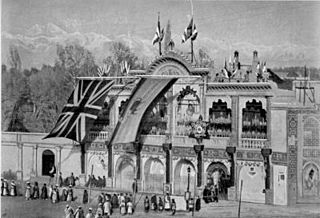
Reza Shah Pahlavi was an Iranian military officer, politician, and first Shah of the House of Pahlavi of the Imperial State of Iran and father of the last Shah of Iran. He reigned from 1925 until he was forced to abdicate after the Anglo-Soviet invasion of Iran in 1941. A modernizer, Reza Shah clashed with the Shia clergy, but also introduced many social, economic, and political reforms during his reign, ultimately laying the foundation of the modern Iranian state. Therefore, he is regarded by many as the founder of modern Iran.
This is a timeline of aviation history, and a list of more detailed aviation timelines. The texts in the diagram are clickable links to articles.

The Qajar dynasty was an Iranian dynasty founded by Mohammad Khan of the Qoyunlu clan of the Turkoman Qajar tribe.

The Imperial Bank of Persia was a British bank that operated as the state bank and bank of issue in Iran between 1889 and 1929. It was established in 1885 with a concession from the Persian government to Baron Julius De Reuter a German–Jewish banker and businessman who later became a Christian and a British subject.
In the Western world, Persia was historically the common name used for Iran. On the Nowruz of 1935, Reza Shah officially asked foreign delegates to use the Persian term Iran, the endonym of the country, in formal correspondence. Subsequently, the common adjective for citizens of Iran changed from Persian to Iranian. In 1959, the government of Mohammad Reza Pahlavi, Reza Shah's son, announced that both "Persia" and "Iran" could be used interchangeably, in formal correspondence. However, the issue is still debated among Iranians.
The military history of Iran has been relatively well-documented, with thousands of years' worth of recorded history. Largely credited to its historically unchanged geographical and geopolitical condition, the modern-day Islamic Republic of Iran has had a long and checkered military culture and history; ranging from triumphant and unchallenged ancient military supremacy, affording effective superpower status for its time; to a series of near-catastrophic defeats, most notably including the ancient Greek kingdom of Macedon as well as the Asiatic nomadic tribes at the northeastern boundary of the lands traditionally home to the Iranian peoples.

The national emblem of Iran since the Iranian Revolution features four curves and a sword, surmounted by a shadda. It is very similar to the Sikh Khanda symbol. The emblem was designed by Hamid Nadimi, and was officially approved by Ayatollah Ruhollah Khomeini, the first supreme leader of Iran, on 9 May 1980.

The following outline is provided as an overview of and topical guide to Iran:

Iranian monarchism is the advocacy of restoring the monarchy in Iran, which was abolished after the 1979 Revolution.
Iran, officially the Islamic Republic of Iran, is a country in Western Asia.

Pahlavi Iran, officially the Imperial State of Persia until 1935 and the Imperial State of Iran from 1935 to 1979, was the Iranian state under the rule of the Pahlavi dynasty. The dynasty was formed in 1925 and lasted until 1979, when the Pahlavis were overthrown as a result of the Islamic Revolution, which abolished Iran's continuous monarchy and established the present-day Islamic Republic of Iran.
This page is based on this
Wikipedia article Text is available under the
CC BY-SA 4.0 license; additional terms may apply.
Images, videos and audio are available under their respective licenses.







